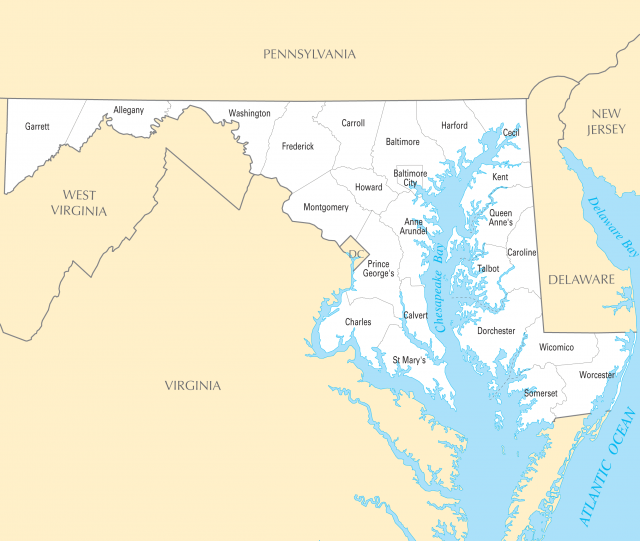The State of Maryland
AT A GLANCE
Name: Maryland was named in honor of Henrietta Maria, queen consort of King Charles I of England.
Nicknames: Free State, Old Line State
Capital: Annapolis
Size: 12,297 sq. mi. (31,972 sq km)
Population: 6,006,401 (2015 est)
Statehood: Maryland became the seventh state on April 28, 1788.
Electoral votes: 10 (2016)
U.S. representatives: 8 (until 2016)
State tree: white oak
State flower: black-eyed Susan
State bird: Baltimore oriole
Highest point: Backbone Mountain, 3,360 ft. (1,024 m)

THE PLACE
Maryland is located in the northeastern corner of the southern states. Maryland's northern border runs along the Mason-Dixon Line, the traditional boundary between the North and the South.
Maryland is split by the Chesapeake Bay, an inlet of the Atlantic Ocean. Maryland has several ports along the bay, including Baltimore, the state's largest city, and Annapolis, the capital.
The portion of Maryland east of the Chesapeake Bay is known as the Eastern Shore, and the part west of the bay is called the Western Shore. Both coastlines are generally low and flat, but much of the Western Shore is hilly to mountainous, with some fertile valleys. Most of Maryland's soil in the west, except for areas along the shoreline, is good for farming.
About 40 percent of the state is forested. Maryland has several lakes, all of which are man-made.
Maryland experiences humid weather conditions, with hot summers and generally mild winters. The state's mountainous northwest can be considerably cooler than shore areas. Rain is frequent throughout the state, and more snow falls in the mountains than elsewhere.
Maryland produces large amounts of crushed stone, which is used in construction. The state also has several coal, natural gas, limestone, and marble deposits.
Facts and Firsts
- In 1696, King Williams School, the first free school in the United States, opened in Annapolis.
- The Maryland State House is the oldest state capitol building still in legislative use.
- In 1791, Maryland gave up land for the nation's capital—Washington, D.C.
- According to legend, Francis Scott Key, a Maryland lawyer, wrote “The Star-Spangled Banner” as he watched the British bombardment of Fort McHenry in Baltimore Harbor in September 1814.
- In 1902, Maryland became the first state to enact a workers' compensation law to support people injured on the job.
THE PAST
Native Americans have lived in Maryland for more than 10,000 years. When Spanish and English explorers first sailed into the Chesapeake Bay 400 years ago, they found several different Algonquian tribes there. Colonists began to settle in the area in 1631, when the first trading post was opened.
In 1632, King Charles I of England gave most of Maryland to Cecilius Calvert, Lord Baltimore. The Calvert family governed the area until the Revolutionary War, except for a brief few years. Tobacco was a valuable crop, and the colony's population grew rapidly. Maryland was also known for its religious tolerance.
During the American Revolution, Maryland residents built cannons and ships in Baltimore for General George Washington's Continental army. Maryland approved the Constitution on April 28, 1788, and became the seventh state of the Union. In 1791, Maryland donated land for the new nation's permanent capital. The capital was looted and burned by the British during the War of 1812. During the Civil War, Maryland remained in the Union even though it was a slaveholding state. Many of Maryland's residents, however, chose to fight for the Confederate cause.
After the war's end, Baltimore's commercial importance grew and it became known as one of the cultural centers of the nation. Maryland factories and shipyards flourished throughout most of the 20th century, although the state, like the rest of the nation, suffered economically during the Great Depression of the 1930s.
During World War II, manufacturing activity increased greatly in Maryland. Baltimore and other cities drew large numbers of workers from nearby states, the population began to expand quickly, and the state became increasingly urban. By the 1960s, the quality of Maryland's roads, transportation systems, schools, and housing had declined. During the 1960s and 1970s, however, many new bridges, roads, airports, houses, and schools were built to meet the growing needs of the state. In 1985, Maryland began an ongoing project to clean up pollution in the Chesapeake Bay.
THE PRESENT
Maryland's location on the Chesapeake Bay has helped it to become and remain one of the most important commercial and shipping states in the nation. Manufacturing is strongest in the Baltimore and Washington, D.C., areas, where industries such as food processing and chemical production flourish.
Maryland is the site of several government bureaus and offices, including the U.S. Naval Academy in Annapolis and Goddard Space Flight Center in Greenbelt.
Maryland is not only a manufacturing and industrial state. Approximately one-third of Maryland is farmland. Many of the state's approximately 13,000 farms produce broilers, or young chickens, which are Maryland's most valuable farm product.
Dairy farms are also important to the state's agricultural economy. Maryland's other farms grow ornamental shrubs and flowers, soybeans, corn, wheat, and many other crops. Maryland has a thriving fishing industry. Valuable catches include blue crab,bluefish, catfish, clams, flounder, mackerel, striped bass, and white perch.
Born in Maryland
- John Wilkes Booth, actor and assassin of Abraham Lincoln
- Tom Clancy, author
- Frederick Douglass, abolitionist
- Philip Glass, composer
- Billie Holiday, jazz-blues singer
- Johns Hopkins, financier
- Francis Scott Key, author of the national anthem
- Thurgood Marshall, jurist
- H.L. Mencken, author
- Charles Willson Peale, painter
- Frank Perdue, farmer and businessman
- Babe Ruth, baseball player
- Upton Sinclair, author
- Harriet Tubman, abolitionist
- Frank Zappa, singer